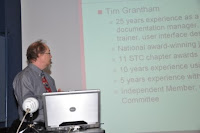By Jim BousquetHave you ever wondered how to properly attribute trademarks to their owners? Finding authoritative sources on correct trademark usage can be difficult, which is why the STC’s Southwestern Ontario Chapter was particularly fortunate to have Richard McClurg, Senior Marketing Manager at ON Semiconductor’s Medical Division, speak about both copyrights and trademarks on March 9. Richard has 17 years of experience applying trademark and copyright guidelines while creating, launching and working with global brands and the related marketing and technical communications.
The bottom line? Following what other companies and publishers do might not be the way to go. As Richard noted, ‘Even in larger organizations, guidelines for claiming and acknowledging copyrights and trademarks may not reflect current law or best practices.’
Copyright
As writers, many of us are somewhat familiar with the concepts, if not the laws, surrounding copyright. Copyright laws exist to balance access to creators’ works with their right to make a living. Creators automatically own the copyright on their work unless the work was part of a job for an employer or client. In these cases the party paying for the work owns the copyright, unless a contract states otherwise.
While notice isn’t required in Canada or most countries, it is required in some so proper notice is a good idea. Proper notice includes (in any order):
• The ‘C in a circle’ symbol (©)
• The year of publication
• The name of the copyright owner
Company style guides should include a format for copyright notices. The actual word copyright isn’t required. Interestingly, the commonly used phrase ‘All rights reserved’ is obsolete. It’s a vestige of the Buenos Aires Copyright Convention, whose signatory countries are all now members of the Berne Convention.
Trademarks
Trademarks distinguish a seller’s product, creating brand awareness and expectation for consumers. Trademarks can be logos, slogans, or even designs (the shape of the Coca-Cola bottle is one). Owens-Corning used the pink colour of their fibreglass insulation as a trademark. Harley-Davidson was unsuccessful in their attempt to register their motorcycles’ familiar rumbling sound as a trademark, because engine noise was deemed to be integral to the function of the product. On the other hand, a Netherlands marketer was able to register the scent of ‘fresh cut grass’ for tennis balls.
Registering a trademark, while not mandatory, provides evidence of ownership and ensures that the mark is unique. In the US, proper use of trademarks can affect the amount of damages the owner can claim in an infringement suit.
Owners can lose the rights to their trademarks if:
• They use them inconsistently
• They fail to police them
• The mark becomes a generic term
The last point explains why some companies seem to have such extensive guidelines and requirements around the use of their trademarks. Corn flakes, zipper, escalator, aspirin and many other generic words were once trademarks. The Google trademark is also in danger of becoming a generic term. Richard pointed out that while the word has made it into some dictionaries, the dictionary definitions are careful to state that Google is a trademark.
So just what are the guidelines to use a trademark properly?
• Distinguish it from surrounding text (by using quotation marks, initial capitals, etc.)
• Use it as an adjective modifying a noun (instead of ‘a Kleenex’, it’s ‘a Kleenex tissue’), or follow with the work brand (as in ‘Band-aid brand adhesive bandages)
• Never pluralize the trademark; instead pluralize the generic word (rather than ‘two Oreos’, it’s ‘two Oreo cookies’)
• Never make the trademark possessive, unless it already is
• Never use the trademark as a verb
• Be consistent and careful to avoid deviations (for example, it’s ‘Coca-Cola’, not ‘CocaCola’; ‘A&W’, not ‘A and W’; and so on); a deviation is a different trademark
Complicating things, some companies have trademarks that are the same as their trade names. For example, Oracle Corporation has a database product with the registered trademark Oracle. While it would be correct to use the possessive when writing about the company (for example, ‘Oracle’s third quarter earnings’), it’s incorrect to refer to the product that way (as in ‘Oracle’s data compression feature’). Similarly, it would be incorrect to use the ® symbol with Oracle the company.
Richard brought this subject to life with plenty of engaging examples. He described which symbols to use when and how to give proper notice in Canadian, US and international markets. For more information, refer to:
• The Canadian Intellectual Property Office (
http://www.cipo.ic.gc.ca/)
• The Canadian Copyright Act (
http://laws.justice.gc.ca/en/C-42)
• The Copyright Handbook: What Every Writer Needs to Know by Stephen Fishman (
http://www.nolo.com/products/the-copyright-handbook-COHA.html)
• Michael Geist’s blog on Canadian copyright reform (
http://www.michaelgeist.ca/)
• The Canadian Trade-marks Act (
http://laws.justice.gc.ca/en/T-13)
• The International Trademark Association (
http://www.inta.org/downloads/documents/2009_TrademarkUse.pdf)
• Patent, Copyright & Trademark by Richard Stim (
http://www.nolo.com/products/patent-copyright-&-trademark-PCTM.html).
About Jim BousquetAfter 14 years as a professional engineer in the database, hearing aid, semiconductor and medical measurement industries, Jim Bousquet (jim.bousquet@primal.com) turned to technical writing and now works at Primal, a semantic technology company in Waterloo. Besides being Southwestern Ontario Chapter’s treasurer, he enjoys running, cooking and playing the bagpipes, and would like to travel much, much more.





























